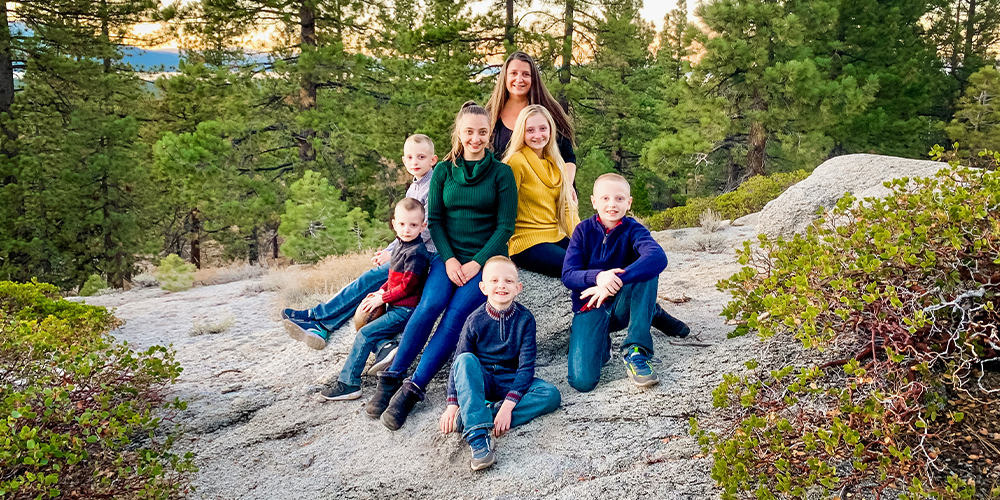Picture this: six kids, a bustling household, and a thriving executive career—all in the same life. That’s been my reality for over a decade, and I’m here to share how I made it work. As a working mother of six children born over 11 years, I’ve navigated the exhilarating, exhausting, and deeply rewarding journey of raising a large family while advancing my career to an executive level. From 2005 to 2016, I gave birth six times, yet I didn’t let the demands of motherhood derail my professional aspirations. Instead, I leaned into strategic decision-making, embraced flexibility, and cultivated a mindset that allowed both my family and career to flourish. Here’s how I did it—and how you can, too, whether you’re parenting one child or many, aiming for the C-suite or simply seeking balance.
 This is our family of 10, including my two grown step-children, and the 6 children we had together. My step children were aged 16 and 12 when Doug and I married in 2003.
This is our family of 10, including my two grown step-children, and the 6 children we had together. My step children were aged 16 and 12 when Doug and I married in 2003.
Strategic Decisions: Aligning Family and Work
Raising six children while climbing the corporate ladder required deliberate choices. Early on, my husband and I set clear priorities: family first, but with room for professional growth. We evaluated every career move through the lens of how it would impact our family’s rhythm. For example, when offered a new role as a Senior Director of Assessment in 2010 that originally required relocation from Texas to Washington, DC, I negotiated a hybrid role, splitting my time between Texas and DC. By demonstrating my value and reliability, I successfully transitioned the role to full-time remote with only occasional DC travel within a few months.
Actionable Tip: Create a family-career decision matrix. List potential career moves or changes (e.g., new job, relocation, longer hours) and evaluate them against factors like family time, financial impact, and personal fulfilment. Share this with your partner or a trusted mentor to ensure alignment.

Working from home in Texas, with an office in DC, was a tremendous blessing, particularly when I was very pregnant and nursing. I was 38 weeks pregnant with my 5th child in this image in November, 2013.
Leaning on Strengths
Knowing my strengths was a game-changer. As a natural planner with strong communication skills, I used these traits to manage both home and work efficiently. At home, I created organizational systems, an accessible color-coded family calendar, and daily and weekly chore responsibilities for each family member, to keep our household running smoothly. With a large, busy family, there were occasional hiccups, but these systems kept us on track. At work, I leveraged my ability to connect with people to build, develop, and mentor strong teams, rooted in trust, and to galvanize teams to achieve strategic results.
Actionable Tip: Take the Working Genius Assessment to determine your working geniuses, competencies, and frustrations. It only takes about 15 minutes, and you may be very surprised about what you can learn about how you get work done with this assessment by Patrick Lencioni. Or, take a strengths assessment like CliftonStrengths or ask colleagues and family to describe your top three qualities. Then, find ways to apply these strengths to both parenting and professional challenges. For example, if you’re great at problem-solving, use that skill to streamline morning routines or tackle workplace inefficiencies.
Work relationships are critical to my success in balancing work and family. As I had seasons of heavy travel, I have thrived by cultivating relationships with mission-aligned colleagues with similar passions.
Embracing Flexibility
With six kids, chaos is inevitable. Sick days, school events, and unexpected tantrums don’t follow a corporate calendar. I learned to embrace flexibility, both at home and work. At the office, I communicated openly with my team about my availability, ensuring I could attend key meetings while occasionally stepping away for family needs, like appointments or school pick-up. At home, I adjusted routines as our family grew, letting go of rigid schedules in favor of what worked in each season.
Real-Life Example: In 2018, I took on a new role as a Chief Assessment Officer in Austin. My boss wanted me to relocate there from San Antonio so that I could be in the office every day. But, after five years of homeschooling, my kids had finally gained acceptance through the lottery into a classical charter school they loved, and moving was not an option. Instead of moving to Austin, I proposed a flexible schedule—working 2-3 days a week in Austin and the other days at home. During my 3-4 hours in the car round trip, I listened to leadership books to build my knowledge and learn new skills. I also answered calls and caught up on personal phone calls. I turned unproductive time into productive time and created a win/win situation.
Actionable Tip: Transform commuting or downtime into growth opportunities. If you have a long commute, listen to audiobooks, podcasts, or leadership training relevant to your career. At home, build flexibility by creating a weekly “buffer plan” that includes backup options for unexpected disruptions, like a trusted neighbor (who in my case happens to be my parents – have I mentioned that I am very blessed!) for emergency pickups or a virtual meeting option for work.


I have spent thousands of hours in the car chauffeuring my kids. I love using that time to have conversations with each of them. Conversations during walks are also a great time to learn more about your kids’ ideas, loves, passions, concerns, and daily events.
Gratitude and Faith
Gratitude kept me grounded through the chaos of diapers, deadlines, and decisions. I learned to pause and celebrate the small wins—a child’s giggle, a project well done, a quiet moment at the end of a long day.
And when things got tough, turning inward—whether through prayer, reflection, or simply breathing in stillness—helped me stay centered. These practices reminded me that my value isn’t measured by perfection, but by presence—in both motherhood and leadership.
Actionable Tip: Each night, try writing down three things you’re thankful for—one tied to family, one to work, and one just for you. Pair it with a grounding ritual that resonates with you, whether it’s meditating, praying, walking, or reflecting in silence. Even ten mindful minutes can gently shift your focus from pressure to presence.
 My daughter has taken gratitude and organization to the next level. This practice keeps her organized, thankful, and prepared for school.
My daughter has taken gratitude and organization to the next level. This practice keeps her organized, thankful, and prepared for school.
Asking for Help
No one thrives alone. I built a network of support: family members who babysat or carpooled, colleagues who covered meetings, and friends who listened. Asking for help wasn’t a sign of weakness—it was a strategy for success.
Real-Life Example: When my third child was born in 2009, I hired a biweekly housekeeper and a lawn keeper to handle cleaning and yard work, a worthwhile investment that freed up my time. As our kids grew, we taught them skills like laundry and lunch prep by age 8, fostering independence while lightening my load. I still treasure that biweekly cleaning as a gift to myself.
Actionable Tip: Make a list of tasks you can delegate, like grocery delivery or carpooling. Then, reach out to your network—family, friends, or paid help—to share the load.
Building a Circle of Mentors
Mentors were my secret weapon. From seasoned executives who coached me on job search strategy and negotiation to veteran moms who shared parenting hacks, these relationships gave me perspective and confidence. As a 51-year-old seasoned mom with executive experience, I still seek out mentors regularly, and I work with a few who inspire me daily. You’re never too old to have a mentor.
Actionable Tip: Identify one or two people in your field or community whose life or career you admire. Invite them for coffee or a virtual chat, and ask specific questions about their journey.

I have met amazing mentors, colleagues, and friends throughout my professional journey. These relationships have blessed my life professionally and personally. Build a circle of advisors, mentors, and trustworthy colleagues who will enrich your life and allow you to flourish towards your purpose.
Giving Myself Grace
Perfectionism is a trap. I learned to let go of unrealistic expectations—like a spotless house or a flawless work record. When my house was a wreck, I ran late to a school pickup or missed out on a desired promotion, I reminded myself that mistakes don’t define me. Grace allowed me to keep moving forward.
Actionable Tip: Practice self-compassion. When you mess up, speak to yourself as you would a friend: “You’re an amazing woman. You did your best and that is what matters. Is there anything that you can learn from this experience that brings you closer to your core purpose?”
Setting Boundaries
Boundaries protected my time and energy. At work, I set clear office hours and avoided logging into my work computer after 7 p.m., except during peak season. At home, I carved out “mom-only” time for self-care, like reading or a nice walk. These boundaries ensured I could show up fully for both roles.
Actionable Tip: Use a calendar to block off non-negotiable time for family, work, and yourself. Communicate these boundaries to your team and loved ones.
Growth Mindset
I viewed challenges as opportunities to learn. When a promotion or job offer didn’t come through or one of my kids struggled with a sport, passion, or relationship, I asked, “What can I learn here?” This mindset turned setbacks into stepping stones.
Actionable Tip: When facing a challenge, journal about it using the prompt: “What’s the lesson in this moment?” This shifts your focus from frustration to growth.
Clear Expectations and Accountability
Clarity was key. At work, I set measurable goals and checked in regularly with my team. At home, my husband and I established family rules—like our recent decision this school year to ban screens during the week—and held everyone accountable. Clear expectations reduced stress and kept us aligned.
Actionable Tip: Hold a weekly family meeting to review goals, chores, and upcoming events. At work, schedule quarterly check-ins with your manager to align on priorities.

Presenting to educators is one of my favorite parts of the job. As COO, I served as the “Integrator,” managing day-to-day operations. While I enjoyed leading the team and improving processes, I realized my heart was with customers, visionaries, and coalitions for change—I wanted to focus on education policy. In 2023, after aligning with my CEO, we created my exit plan—a tough but necessary decision to stay true to my purpose and set clear expectations.
Balancing and Resetting Priorities
Balance isn’t static—it’s a dance. Some seasons demanded more focus on family, like during a newborn phase; others allowed me to lean into work, like when leading a company initiative, or in one job, where I was leading the operations of the entire company. I regularly reassessed priorities to stay aligned with our values.
Actionable Tip: Every three months, do a “priority audit.” List your top five priorities (e.g., family health, career growth, personal hobbies) and evaluate how your time aligns with them. Adjust as needed.
 Since my girls were little, I have tried to be a strong, smart, feminine, and classy leader. I have even incorporated them into various work events when possible. Here is a photo of my older daughter joining me at a Policy Circle event in 2023 at the Texas Governor’s Mansion in Austin..
Since my girls were little, I have tried to be a strong, smart, feminine, and classy leader. I have even incorporated them into various work events when possible. Here is a photo of my older daughter joining me at a Policy Circle event in 2023 at the Texas Governor’s Mansion in Austin..
Embracing the Beauty of Seasons
Life with six children (and two grown stepchildren who were teens when I married their father in 2003) taught me to embrace each season’s unique beauty. The sleepless newborn days gave way to chaotic toddler years, then to the joy of watching my kids become independent. My career followed a similar arc—each phase brought new challenges and rewards.
Real-Life Example: My children have grown up too fast for my taste. I missed a few games, I worked too much in the early days, and I was on my phone too much in recent years. I was late picking them up from a few practices, and I even completely forgot to pick up more than one of my children from school or practice on more than one occasion over the years. Instead of dwelling on guilt, I focus on the quality time that we did have. My kids have so many beautiful memories that we made around our homeschool table, on family trips, on Sunday dinners, reading books together, talking around campfires, playing “Dude, where’s my lunch?,” on car trips, at gymnastics competitions, football games, dance performances, choir concerts, college trips, in Europe with my girls, and so much more. Seasons go by fast, and each one is unique and special in its own way.
Actionable Tip: Reflect on your current “season.” What’s temporary? What’s worth savoring? Write a letter to your future self about what you love about this phase.
Final Thoughts
Raising six children while building an executive career wasn’t easy, but it was worth it. By making strategic decisions, leaning on my strengths, and embracing flexibility, gratitude, and faith, I created a life where both family and work thrived. I leaned on mentors, set boundaries, and gave myself grace, all while staying open to growth and the beauty of each season. You don’t need a large family or a corner office to apply these principles. Whether you’re a mom of one or many, these strategies can help you navigate the juggle of work and family with confidence and joy.
Tracy Gardner, Ph.D. is a seasoned psychometrician and executive leader with 20+ years of experience in educational assessment and strategic operations. She currently serves as Senior Measurement Advisor at Pearson.

